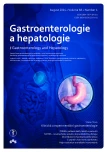The effect of learning peroral endoscopic myotomy (POEM) during the first year of authentication methods in the Czech Republic
Authors:
R. Doležel 1; J. Martínek 2; H. Švecová 2; J. Špičák 2; J. Juhásová 3
Authors‘ workplace:
Chirurgická klinika
2. LF UK a ÚVN, Praha2 Klinika hepatogastroenterologie, IKEM, Praha
1; Ústav živočišné fyziologie a genetiky AV ČR, Liběchov
3
Published in:
Gastroent Hepatol 2014; 68(4): 294-298
Category:
Clinical and Experimental Gastroenterology: Original Article
Overview
Peroral endoscopic myotomy (POEM) is a new (experimental in the Czech Republic) method for treating esophageal achalasia. Since we can assume that its further expansion into clinical practice and the optimization of the training of doctors performing POEM is crucial, we have analyzed the learning curve during the first year of POEM implementation in our country.
Methods:
The prospective study consisted of 30 patients with achalasia who underwent POEM. All surgeries were carried out by one endoscopist who had observed nine clinical performances by an expert endoscopist and trained on ten pigs. Patients were divided into three consecutive homogeneous groups (n = 10). The degree of improvement was assessed according to the time necessary to perform a 1cm myotomy, the frequency of technical errors (non-targeted mucosal injury, CO2 extravasations) and intra-surgery complications.
Results:
POEM was completed successfully in all cases without any major complications. Patients (n = 30; mean age 47.3 ± 14.5 years; BMI 24.9 ± 3.7 kg/m2) were hospitalized 2.5 ± 0.7 days. The average time required to perform a 1cm myotomy was 7.7 ± 2.7 minutes, and as we gained experience this time significantly decreased (p < 0.001). The frequency of unintentional mucosotomy (n = 3; 10%) declined in groups (0.2; 0.1; 0), but the decrease was not significant (p = 0.75). A total of 13 patients (43%) required capnoperitoneum decompression. Subcutaneous emphysema with spontaneous resolution appeared in seven patients (23%). Neither type of CO2 extravasation was affected by our learning (p = 1). The learning curve began to show a significant improvement from the performance of the 12th clinical POEM and a plateau was reached after the 14th clinical performance.
Conclusions:
During the first year of using POEM in clinical practice we observed a significant learning effect in operating time reduction with faster performance of myotomy. Technical errors were primarily not affected by learning. The authors strongly recommend implementation of the POEM method in clinical practice after appropriate training (on pigs) and observation in expert centres. Full competence in the POEM method is achieved after about 23 performances.
Key words:
peroral endoscopic myotomy – esophageal achalasia – learning curve – intra-surgery complications
The authors declare they have no potential conflicts of interest concerning drugs, products, or services used in the study.
The Editorial Board declares that the manuscript met the ICMJE „uniform requirements“ for biomedical papers.
Submitted:
30. 6. 2014
Accepted:
28. 7. 2014
Sources
1. Campos GM, Vittinghoff E, Rabl C et al. Endoscopic and surgical treatments for achalasia: a systematic review and meta-analysis. Ann Surg 2009; 249(1): 45–57. doi: 10.1097/SLA.0b013e31818e43ab.
2. Boeckxstaens GE, Annese V, des Varannes SB et al. Pneumatic dilation versus laparoscopic Heller´s myotomy for idiopathic achalasia. N Engl J Med 2011; 364(19): 1807–1816. doi: 10.1056/NEJMoa1010502.
3. Pasricha PJ, Hawari R, Ahmed I et al. Submucosal endoscopic esophageal myotomy: a novel experimental approach for the treatment of achalasia. Endoscopy 2007; 39(9): 761–764.
4. Inoue H, Minami H, Kobayashi Y et al. Peroral endoscopic myotomy (POEM) for esophageal achalasia. Endoscopy 2010; 42(4): 265–271. doi: 10.1055/s-0029-1244080.
5. Martínek J, Rösch T, Špičák J et al. První „POEM“ (perorální endoskopická myotomie) v České republice. Gastroent Hepatol 2012; 66(6): 475–476.
6. Eleftheriadis N, Inoue H, Ikeda H et al. Training in peroral endoscopic myotomy (POEM) for esophageal achalasia. Ther Clin Risk Manag 2012; 8 : 329–342. doi: 10.2147/TCRM.S32666.
7. Martinek J, Stefanova M, Suchanek S et al. Training of different endoscopic skills on ex vivo animal model. Simul Healthc 2014; 9(2): 112–119. doi: 10.1097/SIH.0b013e31829be99e.
8. Martinek J, Suchanek S, Stefanova M et al. Training on an ex vivo animal model improves endoscopic skills: a randomized, single--blind study. Gastrointest Endosc 2011; 74(2): 367–373. doi: 10.1016/j.gie.2011.04.042.
9. Iacopini F, Bella A, Costamagna G et al. Stepwise training in rectal and colonic endoscopic submucosal dissection with differentiated learning curves. Gastrointest Endosc 2012; 76(6): 1188–1196. doi: 10.1016/j.gie.2012.08.024.
10. Coman RM, Gotoda T, Draganov PV. Training in endoscopic submucosal dissection. World J Gastrointest Endosc 2013; 5(8): 369–378. doi: 10.4253/wjge.v5.i8.369.
11. Draganov PV, Chang M, Coman RM et al. Role of observation of live cases done by Japanese experts in the acquisition of ESD skills by a western endoscopist. World J Gastroenterol 2014; 20(16): 4675–4680. doi: 10.3748/wjg.v20.i16.4675.
12. Kurian AA, Dunst CM, Sharata A et al. Peroral endoscopic esophageal myotomy: defining the learning curve. Gastrointest Endosc 2013; 77(5): 719–725. doi: 10.1016/j.gie.2012.12.006.
Labels
Paediatric gastroenterology Gastroenterology and hepatology SurgeryArticle was published in
Gastroenterology and Hepatology

2014 Issue 4
Most read in this issue
- Efficiency and safety of silymarine in patients with chronic liver diseases – multicenter, prospective, open clinical trial IMHOTEP
- High-resolution anorectal manometry – update in the diagnosis of anorectal disorders
- Diverticular disease
- New development in the treatment of acute and chronic diarrhea in the Czech Republic – Tammex family and Tammex family plus
